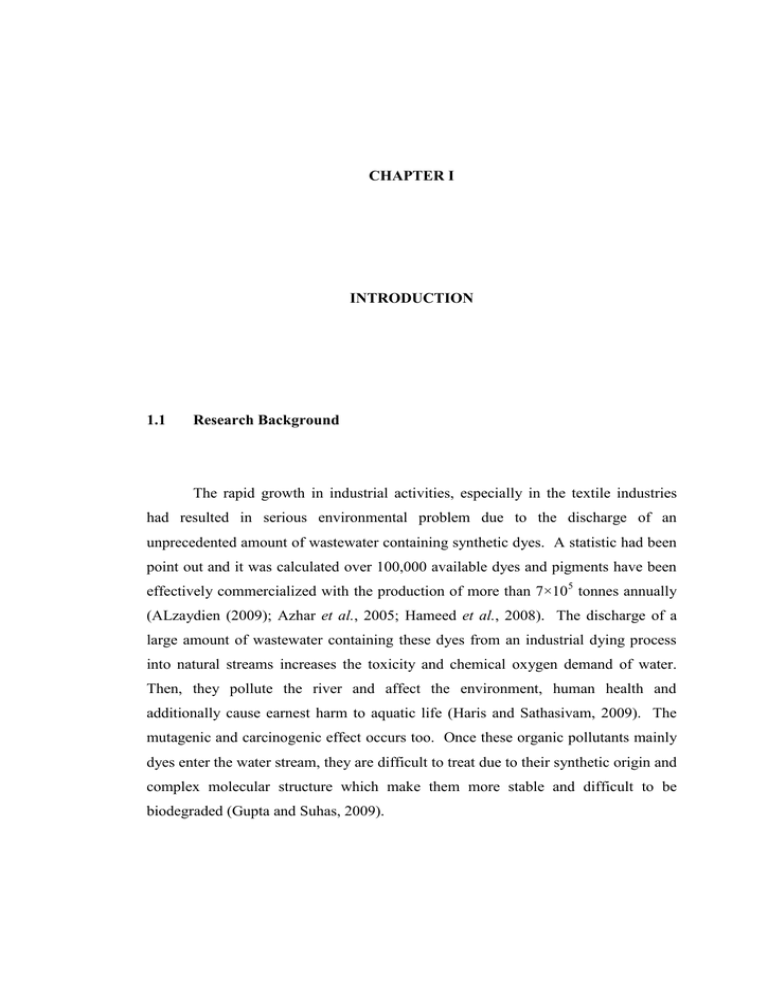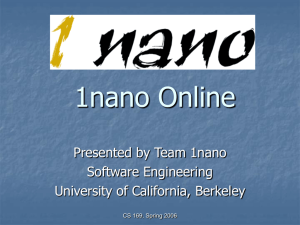The rapid growth in industrial ... had resulted in serious environmental ... CHAPTER I
advertisement

CHAPTER I INTRODUCTION 1.1 Research Background The rapid growth in industrial activities, especially in the textile industries had resulted in serious environmental problem due to the discharge of an unprecedented amount of wastewater containing synthetic dyes. A statistic had been point out and it was calculated over 100,000 available dyes and pigments have been effectively commercialized with the production of more than 7×105 tonnes annually (ALzaydien (2009); Azhar et al., 2005; Hameed et al., 2008). The discharge of a large amount of wastewater containing these dyes from an industrial dying process into natural streams increases the toxicity and chemical oxygen demand of water. Then, they pollute the river and affect the environment, human health and additionally cause earnest harm to aquatic life (Haris and Sathasivam, 2009). The mutagenic and carcinogenic effect occurs too. Once these organic pollutants mainly dyes enter the water stream, they are difficult to treat due to their synthetic origin and complex molecular structure which make them more stable and difficult to be biodegraded (Gupta and Suhas, 2009). 2 In recent times, advances oxidation process (AOPs) is an emerging technology for an efficient treatment of industrial wastewater containing dyes. This process involves simultaneous use of more than one oxidation process to accelerate the production of reactive hydroxyl free radicals. They are included heterogeneous and homogeneous photocatalysis under ultraviolet (UV) or solar visible irradiation in the presence of hydrogen peroxide, ozone and/or Fenton reagents (Simonsen et al., 2010). The AOPs using heterogeneous semiconductor photocatalysts such as TiO2, Fe2O3, ZnO, CuO, ZrO2, CdS, and SnO2 have gained much interest in the treatment of organic contaminant due to its safe and detoxification nature to the environment (Wahab et al., 2011). Besides, its capability to destruct pollutant at ambient temperature and pressure also become the reason for the researchers to increase their focus on this area. ZnO is one of the important wide band gap semiconductor (3.37 eV), that comparable with TiO2 because of its unique properties and numerous advantages (Kansal et al., 2011). However, ZnO can only absorb a small portion of solar spectrum in the UV region, which results in low photocatalytic efficiency (Xie et al., 2012). In order to improve the efficiency, many studies have been performed to modify this metal oxide. Generally, there are four major techniques have been highlighted in improving the photocatalytic efficiency of such semiconductor: (i) increasing the surface area of the metal oxide by synthesizing nanosized materials, (ii) adding a support such as silica, alumina, zeolite, etc. (iii) creation of a defect structure, and (iv) addition of other metal or semiconductor (Rusu and Yates, 1997; Saleh, 2013). In parallel with the first techniques, electrochemical method has been realized to have many advantageous, particularly in the synthesis of nanoparticles materials. It was reported that several nanosized particles such as α-Fe2O3, ZrO2 and CuO were easily prepared using a simple electrochemical method (Jaafar et al., 2012; Jalil et al., 2013; Sapawe et al., 2012), and they were successfully used as photocatalyst in the decolorization of various dyes. 3 On the other hand, the large surface area and high adsorption capacity are very important to increase the photocatalytic acvivity of semiconductor. The addition of support is a feasible approch (Pang et al., 2014). The studies on the mesoporous silica (MS) as support materials have received much attention. The MS materials, such as MCM-41 and SBA-15, have been extensively investigated due to their properties such as high surface area, highly uniform pore distribution, tunable pore size and unique hosting (Mihai et al., 2010). In response to this, mesostructured silica nanoparticles (MSN) has become increasingly important because it also has such properties which offers considerable potential as an excellent solid support for immobilization of heterogeneous catalysts. The generation of defect structure mainly oxygen vacancy has been extensively investigated. It has been revealed that oxygen vacancy can behave as important adsorption and active sites for heterogeneous catalysis, which are able to strongly influence the activity of the catalyst (Pan et al., 2013). The modification of mesoporous materials using alkaline treatment is one of the beneficial approach to generate this oxygen vacancy. The addition of a narrow band gap semiconductor with another having broad band gap was reported to enhance the photocatalytic activity by suppressed the recombination of photogenerated electron–hole pairs (Sathishkumar et al., 2011). The preparation of ZnO-CuO nanocomposites has been recognized to improve photocatalytic activity toward degradation of methyl orange and methyl blue when compared with bare ZnO (Saravanan et al., 2013b). Although the large efforts have been undertaken to find a suitable catalyst for photocatalytic decolorization of dyes in wastewater, a lot of fundamental issues are not clear yet. There is still lack of report on the possible interaction between metal and support material which provide active sites to enhance their photocatalytic activity. Herein, we report a preparation of ZnO supported on MSN using an electrochemical method, in a relatively low temperature and simple experimental set- 4 up. The preparation of ZnO loaded on the alkaline treated MSN by altering the electrolyte condition was also performed. Then, a second metal, Cu was introduced into ZnO/MSN catalyst to enhance their catalytic activity toward decolorization of methyl orange (MO) dye. Next, optimization process was carried out using response surface methodology (RSM). Lastly, the potential used of the optimum catalyst was investigated on photodecolorization of simulated dye wastewater. 1.2 Problem Statement and Hypothesis Recently, the development in manufacturing industries such as textile, foods, cosmetics and others leads to the usage of organic compound in the production of a wide variety of commercial products. This process causes the discharge of many different types of organic compounds, especially dyes into water bodies. The discharge of the effluents without treatment will cause harm to the environment and also human health. For the treatment reason, various techniques such as adsorption (Karim et al., 2012), coagulation and flocculation, oxidation or ozonation (Malik and Saha, 2003), and membrane separation (Ciardelli et al., 2001) had been developed from time to time. However, these conventional techniques still have their drawbacks, especially in their efficiency to remove pollutants and waste disposal problem. AOPs appears to be a promising technique to remove the pollutants. This process have an ability to degrade the organic dyes and other nontoxic inorganic compounds without bringing secondary pollution (Zhu et al., 2012). In the past two decades, TiO2 is frequently used as photocatalyst for photodegradation of organic compound. However TiO2 tend to aggregate and uneconomical for large scale of production. ZnO has gained much interest as a photocatalyst to replace the use of TiO2. However, the large band gap and high recombination rate of photo-induced electron–hole pairs limited its practical application in photocatalysis. Therefore, 5 several other studies have been developed to improve the activity of ZnO catalyst, such as adding of support material or second metal and by enhancing the defect sites as reported previously (Dai et al., 2014; Liu et al., 2008; Wang et al., 2012). Unfortunately, the detail studies on metal-support interaction and influence of the defect site rich-support is still scanty. Therefore, it is desirable to explore the structure of the synthesized catalysts, study the interaction between metal and support materials as well as the formation of defect sites, which play significant roles in enhancing the photocatalytic efficiency. It was hypothesized that the preparation of ZnO and CuO supported on mesostructured silica nanoparticles (CuO-ZnO/MSN) via an electrochemical method give a great advantage as a facile synthesis route. The introduction of Zn species onto a silica framework via desilication followed by substitution was expected to form an active site, Si-O-Zn bond which enhanced the photocatalytic activity. Additionally, the alkaline treatment of MSN with ammonium hydroxide (NH4OH) resulting in the restructuring of the silica framework by the creation of oxygen vacancies was expected to be a factor that enhanced the catalytic performance. Lastly, the introduction of the second metal, Cu to was also anticipated to endow extra properties on the characteristic of the catalyst, which believed to demonstrate the synergistic effect between both metal and support, thus also enhanced the photocatalytic activity 1.3 Objectives of Research The objectives of this research are: 1. To synthesize and characterize the CuO-ZnO/MSN catalysts. 6 2. To determine the effect of Zn loading, alkaline treatment of MSN support and Cu loading toward the catalyst photoactivity. 3. To optimize the photodecolorization of MO over CuO-ZnO/MSN by response surface methodology (RSM). 4. To determine the potential of CuO-ZnO/MSN on photodecolorization of simulated dye wastewater. 1.4 Scopes of Research To complete the objectives of this study, five main scopes are listed below, 1. Synthesis and characterization of the ZnO/MSN based catalysts. The MSN were prepared using a co-condensation and sol–gel method as reported in previous literature (Karim et al., 2012). The ZnO loaded onto MSN based catalysts were prepared using electrochemical method. Then the catalysts were characterized using X-ray diffraction (XRD), Fourier Transform Infrared Spectroscopy (FT-IR), field emission scanning electron microscopy with energy dispersive X-ray (FESEM/EDX), transmission electron microscopy (TEM), N2 physisorption, Nuclear Magnetic Resonance 29 Spectroscopy Si Magic Angle Spinning (29Si MAS NMR), photoluminescence (PL), ultraviolet-visible/diffuse reflectance spectrometer (UV-vis DRS), X-ray photoelectron spectroscopy (XPS), electron spinning resonance (ESR) and cyclic voltammetry (CV). 7 2. Determination of the effect of Zn loading, alkaline treatment of MSN support and Cu loading toward the catalyst photoactivity i. Determine the effect of Zn loading. Three different weight loading of Zn (1, 5 and 10 wt%) were loaded on the MSN via electrochemical method and the catalysts were evaluated for photodecolorization of MO dye. ii. Determine the effect of alkaline treatment of MSN support. The structure of MSN was tailored using a different concentration of alkaline base, NH4OH (0, 0.5, 1.0 and 2.0 M), added into the electrolyte mixture. A 5 wt% of Zn was loaded into the treated MSN, and the catalysts were evaluated for the photodecolorization of MO dye. iii. Determine the effect of Cu loading onto ZnO/MSN catalyst. The 1, 3, and 5 weight% of Cu were loaded onto ZnO/MSN catalyst by changing the Zn plate anode with Cu plate. Besides, the effect of the metal introduction sequence was studied by changing the metal electrolysis order. Then, the catalysts were evaluated for the photodecolorization of MO dye. 3. Optimization of the photodecolorization of MO over CuO-ZnO/MSN by response surface methodology (RSM). The optimum condition for photodecolorization of MO over CuO-ZnO/MSN catalyst was identified by RSM experiment using central composite design (CCD) developed by Statictica 6.0 StatSoft. The parameters are including initial pH (2–8), adsorbent dosage (0.4 - 1.6 g L-1), and Cu loading (1-5 wt %). These parameters were chosen based on the results of preliminary studies 8 that have been conducted. The performance of the catalyst was evaluated by analyzing the response of photodecolorization percentage of MO. 4. Determination of the potential of CuO-ZnO/MSN on photodecolorization of simulated dye wastewater. The potential of the best catalyst was studied for photodecolorization of simulated dye wastewater which contained of four types of dyes, including methyl orange, methylene blue, congo red and malachite green. 1.5 Significance of Research This study was conducted to synthesize the ZnO/MSN based catalysts. A detail investigation of physicochemical properties of the catalysts as well as the photocatalytic activity was conducted. It was well known that ZnO catalyst attracts much attention on photocatalytic application. Moreover, several studies had been done to further improve the photocatalytic activity of ZnO by adding support materials and second metal. However, the detail discussion on the properties related to the structure was still scanty in this area. It will be a good contribution to study the effect of modification of ZnO which enhanced its photoactivity. 1.6 Thesis Outline This thesis was divided into five chapters. In Chapter 1, an introduction is given about the commercial use of dyes in industries and the importance of dye 9 removal in the effluent which generally cause a problem to the environment and human health. The conventional removal techniques of dyes were also mentioned. Besides that, the potential of ZnO as semiconductor photocatalyst and MSN as support material were highlighted. The problem of the current research was stated to give the clear objectives of the present study, while the scopes of study cover the research work done to meet these objectives. Chapter 2 which is a literature review covers the details on previous studies that have been done in order to get the clear view in the synthesis, characterization and photocatalytic efficiency ZnO based catalyst. Chapter 3 or experimental methodology describes in details on the materials and chemical reagents used in the present work, the procedure for catalyst preparation, characterization and photocatalytic reaction which includes experimental setup and analysis calculation. Chapter 4 focuses on results and discussion comprehensively which divided into five parts, (i) effect of Zn loading and its photocatalytic activity, (ii) effect of the alkaline treatment of MSN support and the catalyst photoactivity, (iii) effect of Cu loading on ZnO/MSN and its photoactivity, (iv) optimization of photodecolorization of MO over CuO-ZnO/MSN by response surface methodology (RSM) and (v) potential of CuO-ZnO/MSN on photodecolorization of simulated dye wastewater. Finally, Chapter 5 consists of the conclusions about the study. The recommendation for future studies were also given in this final chapter.


